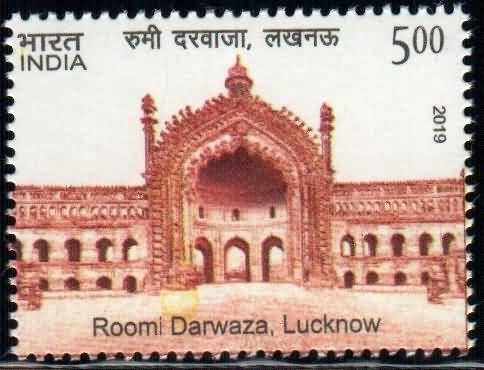Roomi Darwaza, Lucknow

Technical Data
| Stamp Set | Historical Gates of Indian Forts and Monuments |
|---|---|
| Date of Issue | October 19, 2019 |
| Denomination | Rs. 5 |
| Quantity | 500,000 |
| Perforation | 13¼ x 13¾ |
| Printer | Security Printing Press, Hyderabad |
| Printing Process | Wet Offset |
| Watermark | No Watermark |
| Colors | Multicolor |
| Credit (Designed By) | Sh. Brahm Prakash Sh. Pallab Bose |
| Catalog Codes |
Michel IN 3600A Stamp Number IN 3168 Yvert et Tellier IN 3278 Stanley Gibbons IN 3680 |
| Themes | Fortresses / Strongholds | Gates |
An Iconic Symbol of Awadhi Grandeur
The Rumi Darwaza, often called the Turkish Gate, is one of the most magnificent architectural landmarks of Lucknow, the capital city of Uttar Pradesh. This grand gateway stands as a symbol of the artistic brilliance and cultural opulence of the Nawabi era. Built in 1784 under the patronage of Nawab Asaf-ud-Daula, the Rumi Darwaza is a stunning example of Awadhi architecture, reflecting a fusion of Indian and Islamic design elements.
Architectural Excellence and Design
Standing at an impressive height of 60 feet, the Rumi Darwaza was inspired by the Sublime Porte (Bab-i-Hümayun) in Istanbul, Turkey, from which it derives its name “Rumi,” meaning Roman (in reference to the Byzantine Empire). The gateway was constructed as part of a famine relief project, providing employment to thousands of workers during a time of hardship a testament to the Nawab’s compassion and foresight.
The structure features delicate carvings, floral motifs, and ornamental arches, showcasing the elegance of Awadhi craftsmanship. Its majestic proportion and symmetrical design make it a striking example of late Mughal and Persian architectural influence. The upper portion of the gate once held a huge lantern, illuminating the structure at night, giving the impression of a city bathed in soft, golden light.
Historical Significance
Originally, the Rumi Darwaza served as the main entrance to the old city of Lucknow, marking the transition from the royal enclave to the bustling heart of the city. It symbolized the power and prestige of the Nawabs of Awadh, who were renowned patrons of art, architecture, music, and literature.
During the reign of the Nawabs, the gateway also served as the entrance to a now-demolished palace, representing both royal dignity and architectural sophistication. Over the centuries, it has witnessed the evolution of Lucknow from the grandeur of the Nawabi period to the colonial era and beyond.
A Timeless Emblem of Lucknow
Today, the Rumi Darwaza stands not just as an architectural marvel but as an emblem of Lucknow’s identity. It continues to be the most photographed monument in the city and features prominently in art, literature, and philatelic releases. The structure’s unique blend of strength and elegance has made it a timeless testament to Lucknow’s glorious past.
Commemorative Postage Stamp
To honor India’s architectural treasures, the Department of Posts issued a commemorative postage stamp on the Rumi Darwaza, Lucknow as part of the series on Historical Gates of Indian Forts and Monuments.
The stamp celebrates the Rumi Darwaza as a masterpiece of Awadhi architecture and a symbol of cultural pride, embodying the grandeur, grace, and timeless beauty of India’s architectural legacy.

Leave a Comment
You must be logged in to post a comment.